Fine Soil Texture Is Conducive to Crop Productivity and Nitrogen Retention in Irrigated Cropland in a Desert-Oasis Ecotone, Northwest China
Abstract
:1. Introduction
2. Materials and Methods
2.1. Study Area
2.2. Experimental Design and Field Management
2.3. The Leaching Pit
2.4. Sampling and Measurements
2.4.1. Soil Water Storage
2.4.2. Soil Water Balance
2.4.3. Plant N Uptake
2.4.4. Soil N Residual
2.4.5. NO3−-N Dynamics in Soil Solution
2.4.6. N Leaching
2.4.7. Water- and Nitrogen-Use Efficiencies
2.5. Data Analysis
3. Results
3.1. Soil Texture
3.2. Soil Moisture
3.2.1. Dynamics of Soil Water Content
3.2.2. Water Balance and WUE
3.3. Apparent Nitrogen
3.3.1. Dynamic of NO3−-N Concentration in Soil Solution
3.3.2. Residual of NO3−-N in Soil Profile
3.3.3. Plant Biomass Production and N Uptake
3.3.4. N Leaching, N Balance, and NFUE
4. Discussion
4.1. Impact of Soil Texture on Water Balance and WUE
4.2. Impact of Soil Texture on N Balance and NFUE
4.3. Regional Soil and Water Management Practices
5. Conclusions
Author Contributions
Funding
Institutional Review Board Statement
Informed Consent Statement
Data Availability Statement
Conflicts of Interest
References
- Yu, C.; Huang, X.; Chen, H.; Godfray, H.C.J.; Wright, J.S.; Hall, J.W.; Gong, P.; Ni, S.Q.; Qiao, S.C.; Huang, G.R. Managing nitrogen to restore water quality in China. Nature 2019, 567, 516–520. [Google Scholar] [CrossRef] [PubMed]
- Xiao, Q.Y.; Dong, Z.X.; Han, Y.; Hu, L.; Hu, D.N.; Zhu, B. Impact of soil thickness on productivity and nitrate leaching from sloping cropland in the upper Yangtze River Basin. Agric. Ecosyst. Environ. 2021, 311, 107266–107275. [Google Scholar] [CrossRef]
- Yang, S.H.; Wu, H.Y.; Dong, Y.; Zhao, X.R.; Song, X.D.; Yang, J.L.; Hallett, P.D.; Zhang, G.L. Deep Nitrate Accumulation in a Highly Weathered Subtropical Critical Zone Depends on the Regolith Structure and Planting Year. Environ. Sci. Technol. 2020, 54, 13739–13747. [Google Scholar] [CrossRef] [PubMed]
- Acutis, M.; Ducco, G.; Grignani, C. Stochastic use of the LEACHN model to forecast nitrate leaching in different maize cropping systems. Eur. J. Agron. 2000, 2, 191–206. [Google Scholar] [CrossRef]
- Zhang, Y.Y.; Zhao, W.Z.; Fu, L. Soil macropore characteristics following conversion of native desert soils to irrigated croplands in a desert-oasis ecotone, Northwest China. Soil Tillage Res. 2017, 168, 176–186. [Google Scholar] [CrossRef]
- Lu, J.; Bai, Z.H.; Velthof, G.L.; Wu, Z.G.; Chadwick, D.; Ma, L. Accumulation and leaching of nitrate in soils in wheat-maize production in China. Agric. Water Manag. 2019, 212, 407–415. [Google Scholar] [CrossRef]
- Xu, Z.W.; Zhang, X.Y.; Yu, G.R.; Sun, X.M.; Wen, X.F. Review of dual stable isotope technique for nitrate source identification in surface- and groundwater in China. Environ. Sci. 2014, 35, 3230–3238. (In Chinese) [Google Scholar]
- Perego, A.; Basile, A.; Bonfante, A.; De Mascellis, R.; Terribile, F.; Brenna, S.; Acutis, M. Nitrate leaching under maize cropping systems in Po Valley (Italy). Agric. Ecosyst. Environ. 2012, 147, 57–65. [Google Scholar] [CrossRef]
- Quemada, M.; Baranski, M.; Nobel-de Lange, M.N.J.; Vallejo, A.; Cooper, J.M. Meta-analysis of strategies to control nitrate leaching in irrigated agricultural systems and their effects on crop yield. Agric. Ecosyst. Environ. 2013, 174, 1–10. [Google Scholar] [CrossRef] [Green Version]
- Wang, Y.; Ying, H.; Yin, Y.; Zheng, H.F.; Cui, Z.L. Estimating soil nitrate leaching of nitrogen fertilizer from global meta-analysis. Sci. Total Environ. 2019, 657, 96–102. [Google Scholar] [CrossRef]
- Nyiraneza, J.; Zebarth, B.J.; Ziadi, N.; Sharifi, M.; Burton, D.L.; Drury, C.F.; Bittman, S.; Grant, C.A. Prediction of soil nitrogen supply in corn production using soil chemical and biological indices. Soil Sci. Soc. Am. J. 2012, 76, 925–935. [Google Scholar] [CrossRef]
- Chen, L.F.; He, Z.B.; Zhao, W.Z. Soil structure and nutrient supply drive changes in soil microbial communities during conversion of virgin desert soil to irrigated cropland. Eur. J. Soil Sci. 2020, 71, 768–781. [Google Scholar] [CrossRef]
- Su, Y.Z.; Yang, R.; Liu, W.J.; Wang, X.F. Evolution of Soil Structure and Fertility after Conversion of Native Sandy Desert Soil to Irrigated Cropland in Arid Region, China. Soil Sci. 2010, 175, 246–254. [Google Scholar] [CrossRef]
- Shareef, M.; Gui, D.W.; Zeng, F.J.; Waqas, M.; Ahmed, Z.; Zhang, B.; Iqbal, H.; Xue, J. Nitrogen leaching, recovery efficiency, and cotton productivity assessments on desert-sandy soil under various application methods. Agric. Water Manag. 2019, 223, 105716–105724. [Google Scholar] [CrossRef]
- Cambouris, A.N.; Ziadi, N.; Perron, I.; Alotaibi, K.D.; Luce, M.S.; Tremblay, N. Corn yield components response to nitrogen fertilizer as a function of soil texture. Can. J. Soil Sci. 2016, 96, 386–399. [Google Scholar] [CrossRef]
- Yang, R.; Su, Y.-Z.; Wang, T.; Yang, Q. Effect of chemical and organic fertilization on soil carbon and nitrogen accumulation in a newly cultivated farmland. J. Integr. Agric. 2016, 15, 658–666. [Google Scholar] [CrossRef] [Green Version]
- Wang, L.S.; He, Z.B.; Li, J. Assessing the land use type and environment factors affecting groundwater nitrogen in an arid oasis in northwestern China. Environ. Sci. Pollut. Res. 2020, 27, 40061–40074. [Google Scholar] [CrossRef]
- Mi, L.; Xiao, H.; Zhang, J.; Yin, Z.; Shen, Y. Evolution of the groundwater system under the impacts of human activities in middle reaches of Heihe River Basin (Northwest China) from 1985 to 2013. Appl. Hydrogeol. 2016, 24, 971–986. [Google Scholar] [CrossRef]
- Dong, Q.; Dang, T.H.; Guo, S.L.; Hao, M.D. Effect of different mulching measures on nitrate nitrogen leaching in spring maize planting system in south of Loess Plateau. Agric. Water Manag. 2019, 213, 654–658. [Google Scholar] [CrossRef]
- Abbas, M.S.; Akmal, M.; Khan, K.S. Zn Ferti-fortification of Wheat (Triticum aestivum, L.) Using Zinc Enriched Compost and Biochar in Rainfed Area. Commun. Soil Sci. Plant Anal. 2021, 4, 1–16. [Google Scholar] [CrossRef]
- Liang, J.; He, Z.; Shi, W. Cotton/mung bean intercropping improves crop productivity, water use efficiency, nitrogen uptake, and economic benefits in the arid area of Northwest China. Agric. Water Manag. 2020, 240, 106277. [Google Scholar] [CrossRef]
- Zhou, H.; Zhao, W.Z. Modeling soil water balance and irrigation strategies in a flood-irrigated wheat-maize rotation system. A case in dry climate, China. Agric. Water Manag. 2019, 221, 286–302. [Google Scholar] [CrossRef]
- Su, Y.Z.; Zhao, W.Z.; Su, P.X.; Zhang, Z.H.; Wang, T.; Ram, R. Ecological effects of desertification control and desertified land reclamation in an oasis–desert ecotone in an arid region: A case study in Hexi Corridor, northwest China. Ecol. Eng. 2007, 29, 117–124. [Google Scholar] [CrossRef]
- Allen, R.G.; Pereira, L.S.; Raes, D.; Smith, M. Crop Evapotranspiration—Guidelines for Computing Crop Water Requirements—FAO Irrigation and Drainage Paper 56; Food and Agriculture Organization of the United Nations: Rome, Italy, 1998. [Google Scholar]
- Ma, Q.; Tao, R.R.; Ding, Y.G. Can Split Application of Slow-Release Fertilizer Improve Wheat Yield, Nitrogen Efficiency and Their Stability in Different Ecological Regions? Agronomy 2022, 12, 407. [Google Scholar] [CrossRef]
- Cui, Z.; Zhang, F.; Chen, X.; Dou, Z.; Li, J. In-season nitrogen management strategy for winter wheat: Maximizing yields, minimizing environmental impact in an over-fertilization context. Field Crops Res. 2010, 116, 140–146. [Google Scholar] [CrossRef]
- Zheng, W.; Wan, Y.; Li, Y. Developing water and nitrogen budgets of a wheat-maize rotation system using auto-weighing lysimeters: Effects of blended application of controlled-release and un-coated urea. Environ. Pollut. 2020, 263, 114383–114393. [Google Scholar] [CrossRef]
- Zhao, G.Q.; Zhou, B.B.; Mu, Y.; Wang, Y.H.; Liu, Y.Q.; Wang, L. Irrigation with Activated Water Promotes Root Growth and Improves Water Use of Winter Wheat. Agronomy 2021, 11, 2459. [Google Scholar] [CrossRef]
- Arunadevi, K.; Singh, M.; Denny, F. Real Time Soil Moisture (RTSM) Based Irrigation Scheduling to Improve Yield and Water-Use Efficiency of Green Pea (Pisum sativum L.) Grown in North India. Agronomy 2022, 12, 278. [Google Scholar]
- Huang, J.; Hartemink, A.E. Soil and environmental issues in sandy soils. Earth Sci. Rev. 2020, 208, 103295–103316. [Google Scholar] [CrossRef]
- Vincent, A.; Benoit, P.; Pot, V.; Madrigal, I.; Delgado-Moreno, L.; Labat, C. Impact of different land uses on the migration of two herbicides in a silt loam soil: Unsaturated soil column displacement studies. Eur. J. Soil Sci. 2007, 31, 320–328. [Google Scholar] [CrossRef]
- Bruand, A.; Hartmann, C.; Lesturgez, G. Physical Properties of Tropical Sandy Soils: A Large Range of Behaviours. 2005. Available online: https://horizon.documentation.ird.fr/exl-doc/pleins_textes/divers16-03/010066536.pdf (accessed on 18 June 2022).
- Yi, J.; Zhao, Y.; Shao, M.A.; Li, H.J.; Jiang, R.; Hill, R.L.; Si, B.C. Hydrological processes and eco-hydrological effects of farmland-forest-desert transition zone in the middle reaches of Heihe River Basin, Gansu, China. J. Hydrol. 2015, 529, 1690–1700. [Google Scholar] [CrossRef]
- Fernandez-Illescas, C.P.; Porporato, A.; Laio, F.; Rodriguez-Iturbe, I. The ecohydrological role of soil texture in a water-limited ecosystem. Water Resour. Res. 2001, 37, 2863–2872. [Google Scholar] [CrossRef]
- Hu, H.Y.; Ning, T.Y.; Li, Z.J.; Han, H.F.; Zhang, Z.Z.; Qin, S.J.; Zheng, Y.H. Coupling effects of urea types and subsoiling on nitrogen-water use and yield of different varieties of maize in northern China. Field Crops Res. 2013, 142, 85–94. [Google Scholar] [CrossRef]
- Yang, X.L.; Lu, Y.L.; Tong, Y.A.; Yin, X.F. A 5-year lysimeter monitoring of nitrate leaching from wheat–maize rotation system: Comparison between optimum N fertilization and conventional farmer N fertilization. Agric. Ecosyst. Environ. 2014, 199, 34–42. [Google Scholar] [CrossRef]
- Brocca, L.; Morbidelli, R.; Melone, F.; Moramarco, T. Soil moisture spatial variability in experimental areas of central Italy. J. Hydrol. 2007, 2, 356–373. [Google Scholar] [CrossRef]
- Cordero, E.; Longchamps, L.; Khosla, R.; Sacco, D. Spatial management strategies for nitrogen in maize production based on soil and crop data. Sci. Total Environ. 2019, 697, 133854. [Google Scholar] [CrossRef]
- Li, C.; Xiong, Y.; Cui, Z.; Huang, Q.Z.; Xu, X.; Han, W.G.; Huang, G.H. Effect of irrigation and fertilization regimes on grain yield, water and nitrogen productivity of mulching cultivated maize (Zea mays L.) in the Hetao Irrigation District of China. Agric. Water Manag. 2020, 232, 106065. [Google Scholar] [CrossRef]
- Delgado, J.A.; Khosla, R.; Bausch, W.C.; Westfall, D.G.; Inman, D. Nitrogen fertilizer management zones reduce potential for nitrate leaching. J. Soil Water Conserv. 2005, 60, 402–410. [Google Scholar]
- Basso, B.; Ritchie, J.T.; Cammarano, D.; Sartori, L. A strategic and tactical management approach to select optimal N fertilizer rates for wheat in a spatially variable field. Eur. J. Agron. 2011, 35, 215–222. [Google Scholar] [CrossRef]
- Sadras, V.O. A quantitative top down view of interactions between stresss: Theory and analysis of nitrogen-water co-limitation in Mediterranean agroecosystems. Aust. J. Agric. Res. 2005, 56, 1151–1157. [Google Scholar] [CrossRef]
- Lal, R.; Shukla, M.K. Principles of Soil Physics; CRC Press: Boca Raton, FL, USA, 2004. [Google Scholar]
- Beusch, C.; Cierjacks, A.; Böhm, J.; Mertens, J.; Bischoff, W.A.; de Araújo Filho, J.C.; Kaupenjohann, M. Biochar vs. clay: Comparison of their effects on nutrient retention of a tropical Arenosol. Geoderma 2019, 337, 524–535. [Google Scholar] [CrossRef]
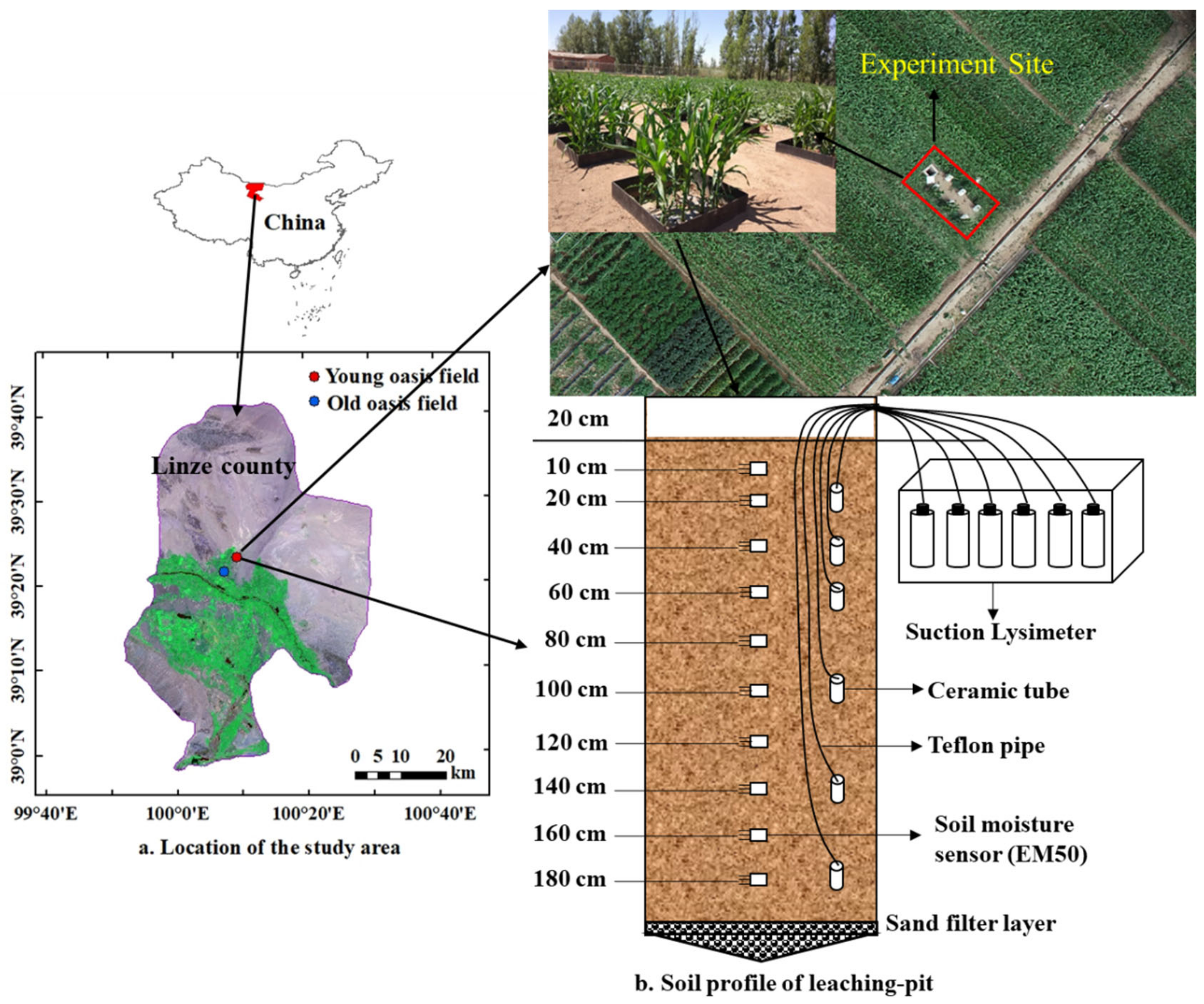

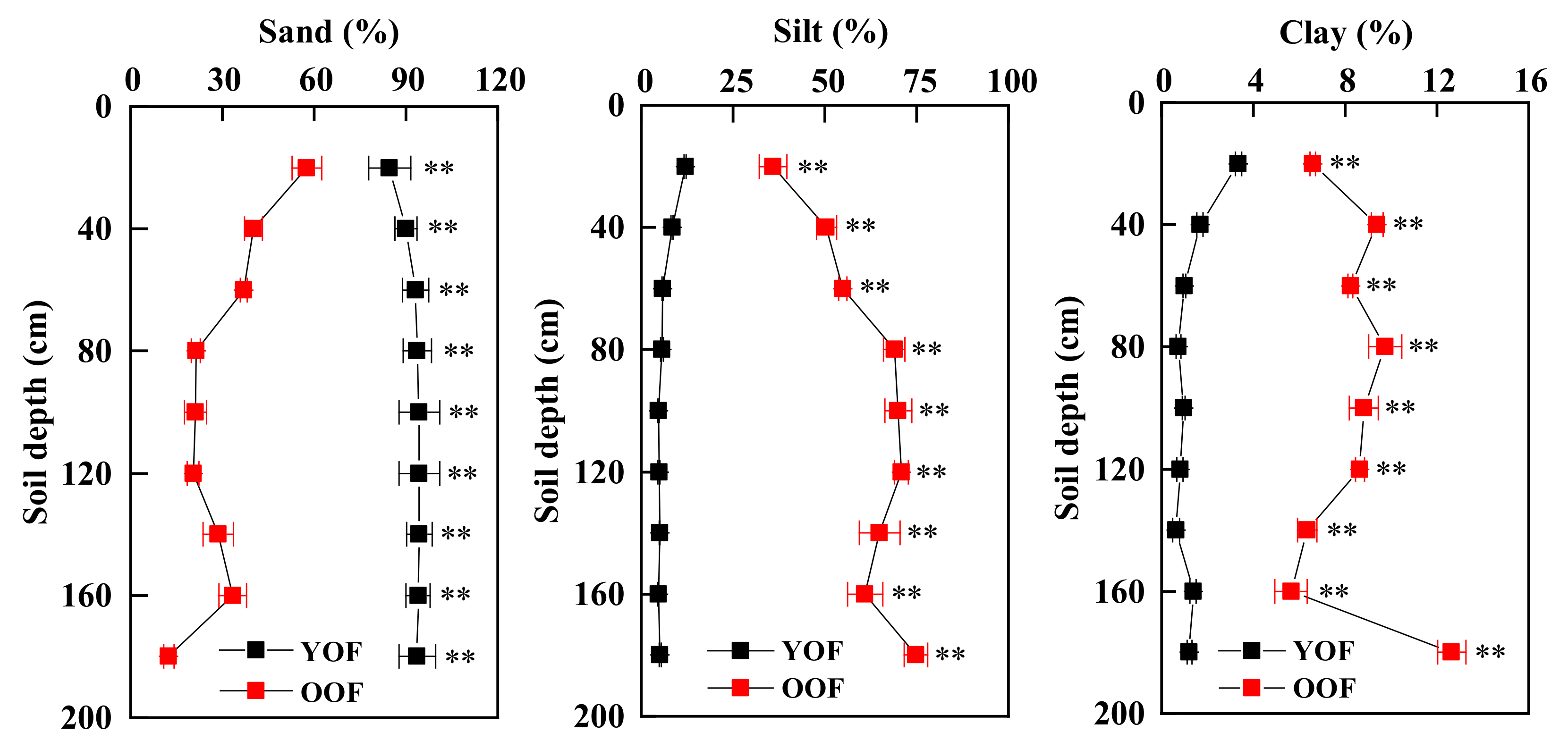
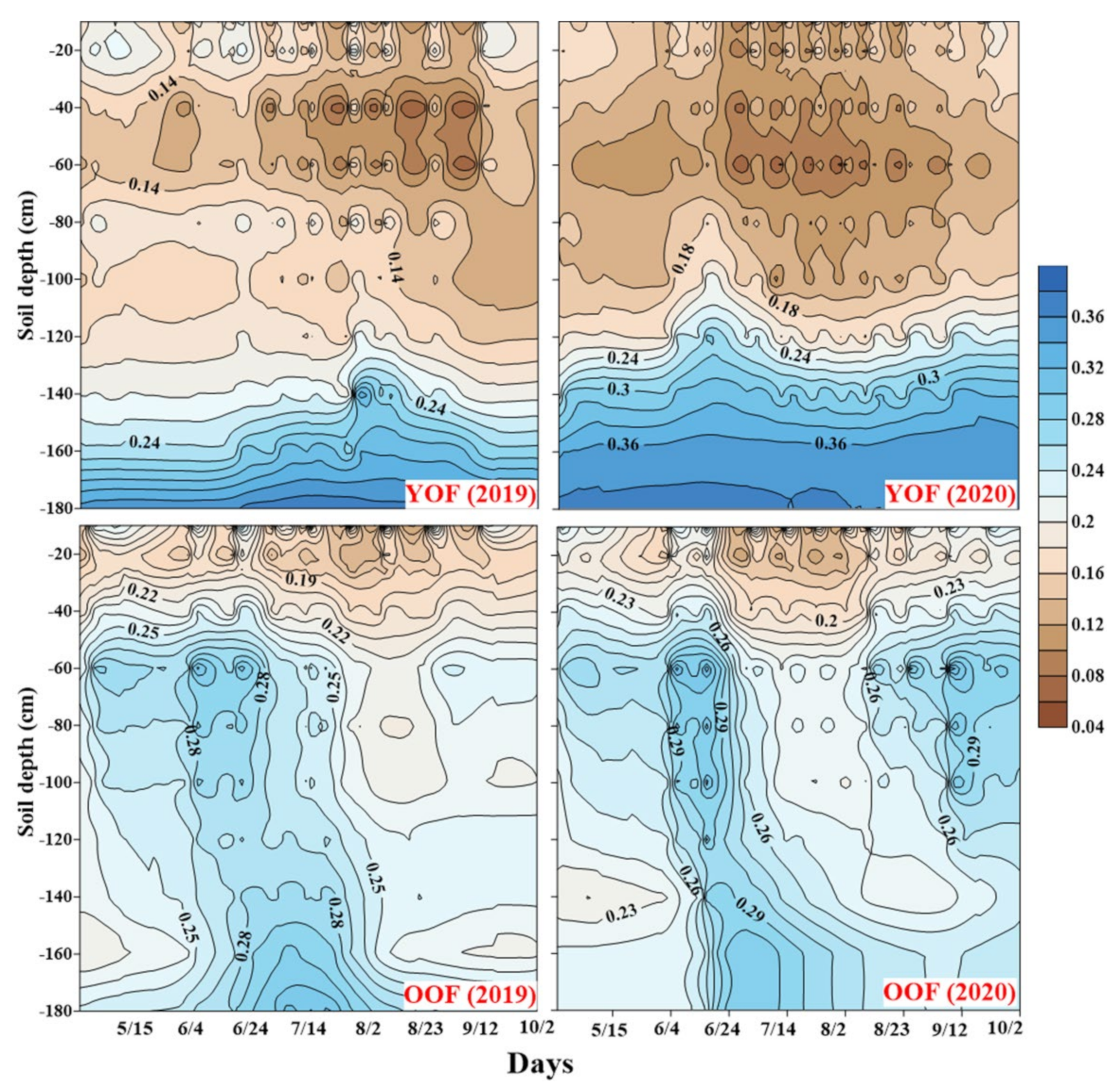
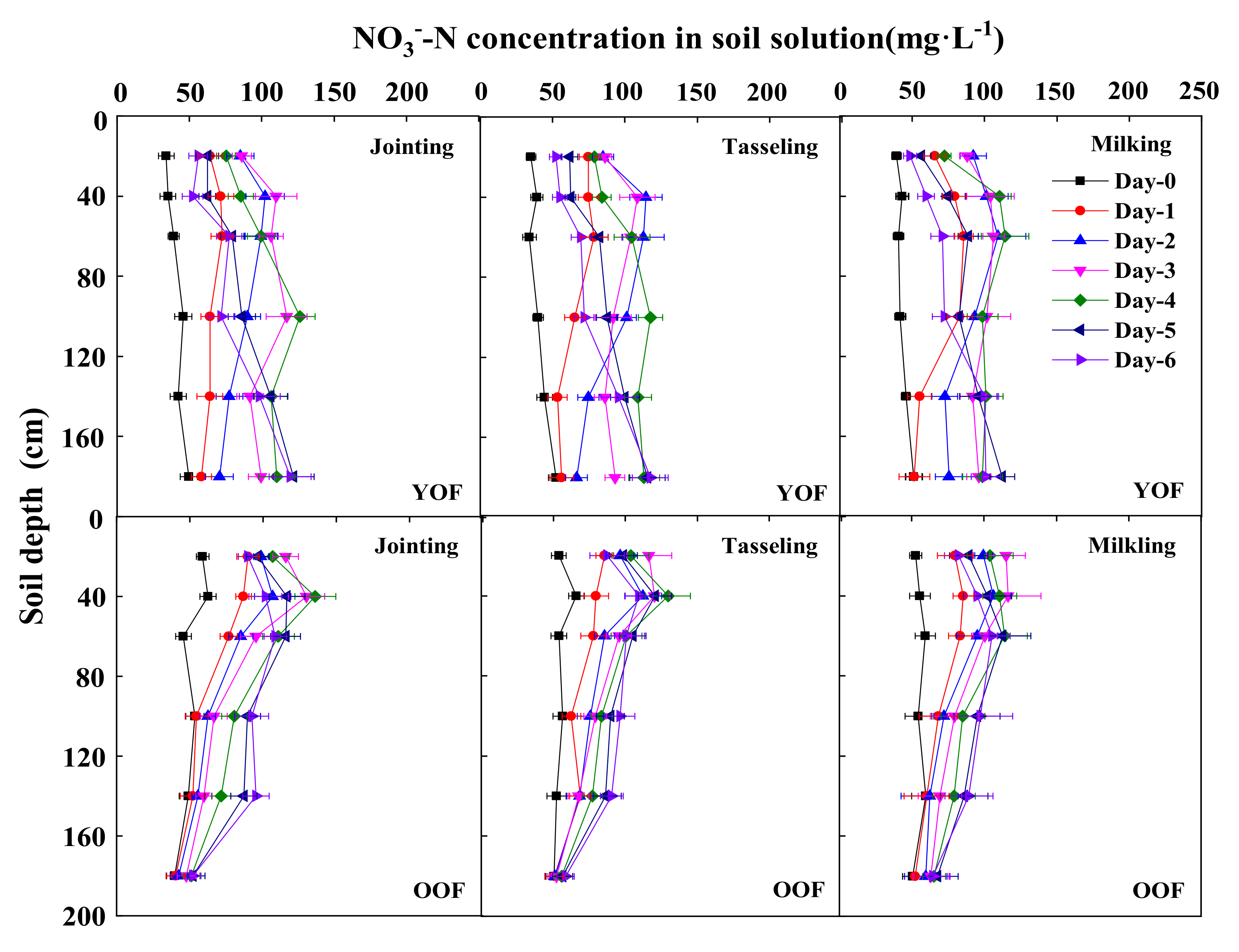
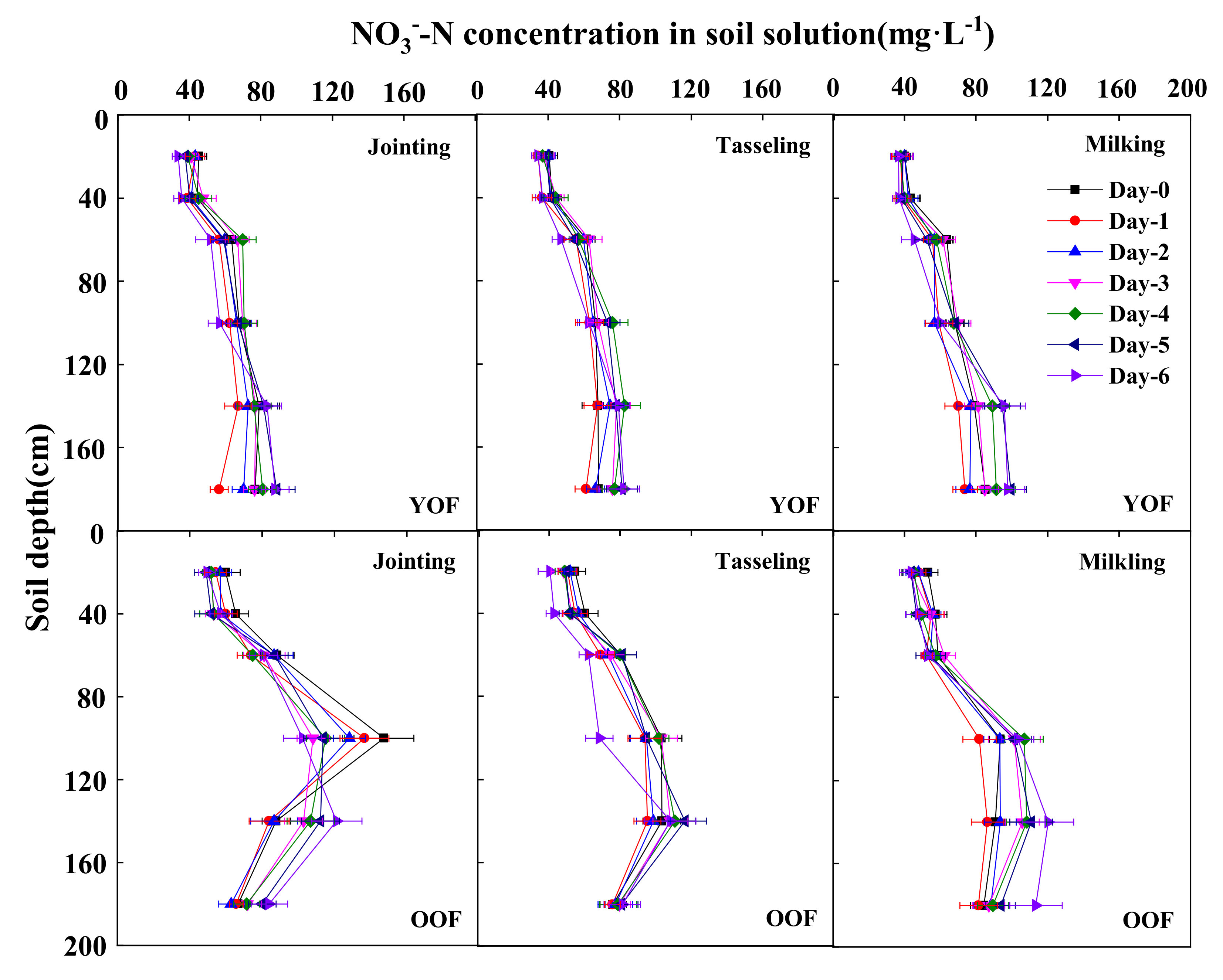
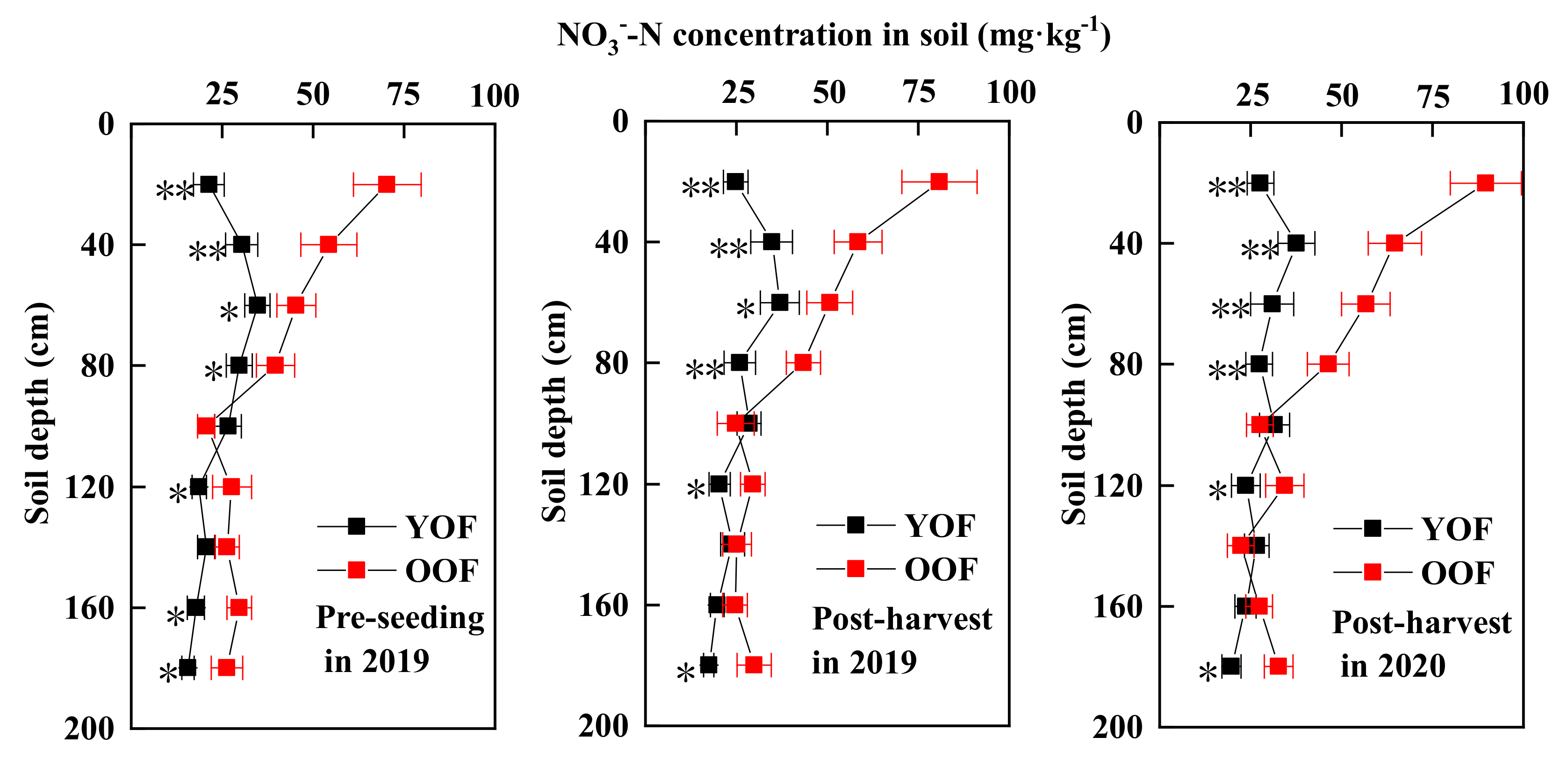
| Items | Soil Layer (cm) | B.D (g·cm−3) | Ks mm/min | F.C (cm3·cm−3) | W.P | O.M | Total N | Total P | Total K |
|---|---|---|---|---|---|---|---|---|---|
| (cm3·cm−3) | (g·kg−1) | (g·kg−1) | (g·kg−1) | (g·kg−1) | |||||
| YOF | 0–20 | 1.61 ± 0.14 | 12.65 ± 2.32 | 0.19 ± 0.01 | 0.07 ± 0.01 | 8.42 ± 1.01 | 0.62 ± 0.62 | 0.49 ± 0.01 | 17.79 ± 1.45 |
| 20–40 | 1.60 ± 0.14 | 12.48 ± 1.27 | 0.18 ± 0.02 | 0.06 ± 0.00 | 7.64 ± 0.92 | 0.58 ± 0.07 | 0.38 ± 0.06 | 17.65 ± 1.16 | |
| 40–60 | 1.59 ± 0.17 | 15.56 ± 1.33 | 0.18 ± 0.01 | 0.04 ± 0.00 | 6.38 ± 0.86 | 0.51 ± 0.04 | 0.44 ± 0.03 | 17.46 ± 1.92 | |
| 60–100 | 1.59 ± 0.11 | 15.83 ± 1.99 | 0.17 ± 0.02 | 0.05 ± 0.00 | 2.18 ± 0.33 | 0.22 ± 0.07 | 0.27 ± 0.01 | 17.15 ± 2.04 | |
| 100–140 | 1.62 ± 0.17 | 16.45 ± 2.31 | 0.17 ± 0.03 | 0.05 ± 0.00 | 1.16 ± 0.21 | 0.17 ± 0.04 | 0.26 ± 0.02 | 17.12 ± 2.13 | |
| 140–180 | 1.60 ± 0.15 | 16.22 ± 1.12 | 0.17 ± 0.03 | 0.04 ± 0.00 | 1.02 ± 0.08 | 0.12 ± 0.02 | 0.20 ± 0.02 | 16.89 ± 1.73 | |
| OOF | 0–20 | 1.41 ± 0.12 | 4.04 ± 0.56 | 0.36 ± 0.02 | 0.20 ± 0.02 | 11.27 ± 1.12 | 0.82 ± 0.15 | 0.95 ± 0.08 | 34.56 ± 3.62 |
| 20–40 | 1.38 ± 0.11 | 4.16 ± 0.89 | 0.37 ± 0.04 | 0.17 ± 0.01 | 9.34 ± 0.88 | 0.81 ± 0.13 | 0.87 ± 0.06 | 35.14 ± 4.28 | |
| 40–60 | 1.34 ± 0.10 | 3.27 ± 0.21 | 0.33 ± 0.03 | 0.20 ± 0.03 | 8.568 ± 1.12 | 0.73 ± 0.12 | 0.89 ± 0.10 | 29.68 ± 1.54 | |
| 60–100 | 1.34 ± 0.08 | 2.87 ± 0.13 | 0.29 ± 0.04 | 0.16 ± 0.01 | 5.76 ± 0.69 | 0.45 ± 0.07 | 0.74 ± 0.10 | 28.59 ± 2.89 | |
| 100–140 | 1.42 ± 0.09 | 2.69 ± 0.14 | 0.27 ± 0.02 | 0.17 ± 0.01 | 5.06 ± 0.37 | 0.28 ± 0.03 | 0.69 ± 0.06 | 22.58 ± 2.78 | |
| 140–180 | 1.46 ± 0.15 | 2.55 ± 0.19 | 0.34 ± 0.02 | 0.14 ± 0.01 | 4.77 ± 0.26 | 0.20 ± 0.04 | 0.57 ± 0.05 | 19.58 ± 1.52 |
| Item | Management Activities | ||||||||
|---|---|---|---|---|---|---|---|---|---|
| Irrigation date (2019) | 4/29 | 6/5 | 6/18 | 6/30 | 7/14 | 7/28 | - | 8/9 | 8/25 |
| Irrigation date (2020) | 4/24 | 5/30 | 6/13 | 6/24 | 7/6 | 7/19 | 7/31 | 8/12 | 8/27 |
| Irrigation (mm) | 90 | 90 | 90 | 90 | 90 | 90 | 90 | 90 | 90 |
| Fertilization type and rate (N-P2O5-K2O, kg·ha−1) | Urea + DPA (110-76-0) | Urea + Compoundfertilizer (110-40-40) | Urea (110-0-0) | ||||||
| Items | 2019 | 2020 | Mean | |||
|---|---|---|---|---|---|---|
| YOF | OOF | YOF | OOF | YOF | OOF | |
| Precipitation | 119.5 | 119.5 | 100.5 | 100.5 | 110 | 110 |
| Irrigation | 720 | 720 | 810 | 810 | 765 | 765 |
| ET | 576.6 | 709.9 ** | 607.6 | 749.4 ** | 592.2 | 729.6 ** |
| SW (0–100 cm) | 119.1 | 215.2 ** | 117.2 | 227.1 ** | 118.2 | 221.2 ** |
| SW (100–200 cm) | 230.2 | 258.6 | 248.4 | 252.8 | 239.3 | 255.7 |
| The variation in SW (0–200 cm) | 28.7 | 94.2 ** | 56.7 | 128.1 * | 42.8 | 112.2 * |
| Deep drainage (>200 cm) | 234.2 ** | 35.4 | 246.2 ** | 33.0 | 240.0 ** | 33.2 |
| WUEET (kg·m−3) | 1.72 | 1.85 | 1.24 | 1.73 * | 1.45 | 1.79 * |
| WUEIrrig (kg·m−3) | 1.48 | 1.69 * | 1.19 | 1.6 * | 1.33 | 1.65 * |
| Depth (cm) | 2019 | 2020 | Mean | |||
|---|---|---|---|---|---|---|
| YOF | OOF | YOF | OOF | YOF | OOF | |
| 0–60 | 37.9 ** | 21.3 | 47.0 ** | 17.3 | 42.45 ** | 19.3 |
| 60–120 | 1.34 | 35.4 ** | −4.47 | 37.1 ** | −1.57 | 36.25 ** |
| 120–200 | 33.7 | 44.1 * | 30.4 | 40.6 * | 32.05 | 42.35 * |
| 0–200 | 67.1 | 89.1 * | 67.8 | 81.6 * | 67.45 | 85.35 ** |
| Year | Treatment | Aboveground Biomass (kg·ha−1) | N Uptake (kg·ha−1) | ||||||
|---|---|---|---|---|---|---|---|---|---|
| Straw Yield | Cob Yield | Grain Yield | Total | Straw | Cob | Grain | Total | ||
| 2019 | YOF | 7121.5 | 1952.3 | 10663.6 | 19679.2 | 54.4 | 12.7 | 121.6 | 188.6 |
| OOF | 8708.6 * | 1959.8 | 12184.7 * | 23127.4 ** | 73.9 ** | 17.4 * | 149.3 * | 240.6 ** | |
| 2020 | YOF | 6168.3 | 1806.1 | 9628.4 | 17602.8 | 52.4 | 14.8 | 115.2 | 182.4 |
| OOF | 8718.9 ** | 22091 ** | 12963.4 ** | 23891.4 ** | 79.7 ** | 16.9 | 154.8 * | 254.3 ** | |
| Items | 2019 | 2020 | Mean | |||
|---|---|---|---|---|---|---|
| YOF | OOF | YOF | OOF | YOF | OOF | |
| 330 | 330 | 330 | 330 | 330 | 330 |
| 67.4 | 67.4 | 79.4 | 79.4 | 73.4 | 73.4 |
| 6.3 | 6.3 | 6.9 | 6.9 | 6.6 | 6.6 |
| 188.6 | 240.6 ** | 182.4 | 254.3 ** | 185.5 | 247.5 ** |
| 39.3 | 56.7 ** | 54.3 * | 46.4 | 46.8 | 51.6 * |
| 32.43 | 27.81 | 20.27 | 27.3 | 26.4 | 27.5 |
| 131.8 ** | 48.2 | 122.9 ** | 48.1 | 127.4 ** | 48.1 |
| 99.4 ** | 20.4 | 102.6 ** | 20.8 | 101.0 ** | 20.6 |
| 44.0 | 58.2 * | 56.7 | 67.5 * | 50.3 | 62.8 * |
| 32.31 | 38.92 * | 29.18 | 39.28 * | 30.75 | 39.1 * |
Publisher’s Note: MDPI stays neutral with regard to jurisdictional claims in published maps and institutional affiliations. |
© 2022 by the authors. Licensee MDPI, Basel, Switzerland. This article is an open access article distributed under the terms and conditions of the Creative Commons Attribution (CC BY) license (https://creativecommons.org/licenses/by/4.0/).
Share and Cite
Wang, L.; He, Z.; Zhao, W.; Wang, C.; Ma, D. Fine Soil Texture Is Conducive to Crop Productivity and Nitrogen Retention in Irrigated Cropland in a Desert-Oasis Ecotone, Northwest China. Agronomy 2022, 12, 1509. https://doi.org/10.3390/agronomy12071509
Wang L, He Z, Zhao W, Wang C, Ma D. Fine Soil Texture Is Conducive to Crop Productivity and Nitrogen Retention in Irrigated Cropland in a Desert-Oasis Ecotone, Northwest China. Agronomy. 2022; 12(7):1509. https://doi.org/10.3390/agronomy12071509
Chicago/Turabian StyleWang, Lisha, Zhibin He, Wenzhi Zhao, Chuan Wang, and Dengke Ma. 2022. "Fine Soil Texture Is Conducive to Crop Productivity and Nitrogen Retention in Irrigated Cropland in a Desert-Oasis Ecotone, Northwest China" Agronomy 12, no. 7: 1509. https://doi.org/10.3390/agronomy12071509





